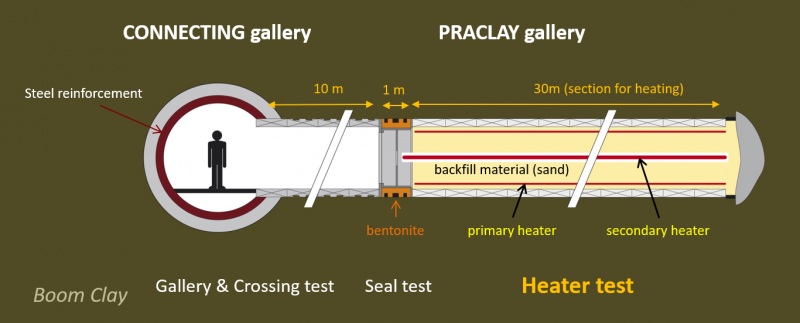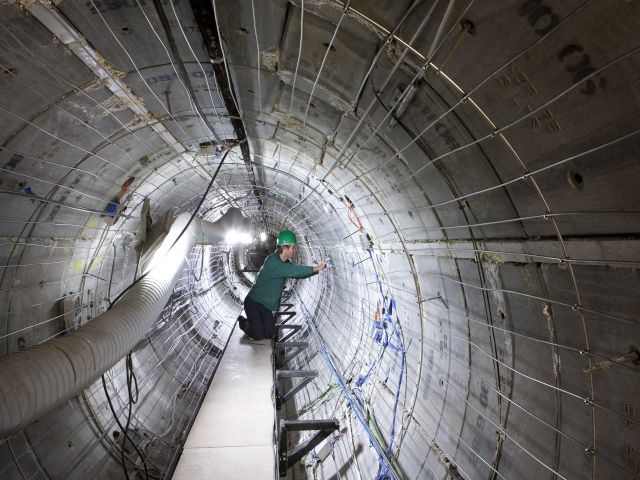PRACLAY Heater test (2014 - 2024)
 |
 |
High-level radioactive waste gives off heat. When this kind of waste is eventually placed in a disposal gallery after an on-surface cooling period of 60 years, this heat will have an impact on the properties of the clay host rock surrounding the disposal galleries. The thermal impact on the clay has already been studied in a number of small-scale heating experiments, such as the ATLAS experiment. In 2007, the 45-metre long PRACLAY gallery was constructed to host the large-scale PRACLAY Heater test. Within the context of the RD&D programme on geological disposal, the construction project is referred to as the PRACLAY Gallery & Crossing test. The goal of the PRACLAY Heater test is to study the impact of heat on the thermo-hydro-mechanical (THM) behaviour of the Boom Clay in conditions that are representative of an actual waste repository and to confirm and refine existing knowledge gained from the small-scale heating experiments.
The Heater test involves heating a 30-metre section of the PRACLAY gallery for 10 years, maintaining a constant temperature of 80°C at the interface between the concrete lining and the Boom Clay. This target temperature is slightly higher than the temperature that is expected in a real repository. The heated part of the gallery is separated from the non-heated part by a seal made of a bentonite ring supported by a cylindrical steel structure. Due to the swelling capacity of the bentonite, the seal hydraulically cuts off the heated part from the non-heated part of the gallery. Together with a water-saturated backfill in the heated part of the gallery, the seal ensures quasi-undrained boundary conditions for the experiment. Studying the behaviour and evolution of the seal is the goal of the PRACLAY Seal test.
Together, the Gallery & Crossing test, the Seal test and the Heater test make up the PRACLAY In-Situ Experiment.
The outcome of the PRACLAY Heater test will be important for the safety assessment and final design of a geological repository.
OBJECTIVES
The main goal of the PRACLAY Heater test is to examine the combined impact of hydro-mechanical disturbances caused by gallery construction and a large-scale thermal load due to heat-emitting high-level waste on the Boom Clay. Such a combined mechanical and thermal load leads to perturbations in the clay and can affect its performance as a host rock in the geological disposal concept for heat-emitting radioactive waste.
More specifically, the goals of the Heater test are to:
- confirm the thermal properties of the Boom Clay on a large scale and refine the constitutive models that describe the thermal evolution of the Boom Clay surrounding a disposal gallery containing heat-emitting radioactive waste;
- estimate the major consequences of the THM impact on the Boom Clay, particularly within the excavation-damaged zone (EDZ), focusing primarily on mechanical damage and hydraulic conductivity;
- assess the long-term stability, under thermal conditions, of the concrete lining surrounding any waste package design, taking into account the temperature criterion of Tmax <100°C around the primary waste package (Bel and Bernier, 2001);
- increase knowledge of the performance and reliability of monitoring devices under thermal stress and heat;
- assess the thermally and excavation-induced geochemical perturbations and their possible impact on radionuclide transport-related parameters; this is not a priority, however, and should not jeopardise achievement of the above objectives.
To cope with possible future changes in the repository design, the test was designed to be as design-independent as possible.
OUTCOME
On 3 November 2014, the heating system was switched on and the target temperature of 80°C was reached on 19 August 2015. Since then, the heating system has been regulated in order to maintain a constant temperature of 80°C at the interface between the lining and the Boom Clay.
Sensors to monitor variations in temperature, pore water pressure, displacement and stresses in the seal, the backfilled part of the gallery, the concrete lining and in a number of boreholes surrounding the gallery continuously generate large amounts of data that are compared with the blind predictions made by modelling. The evolution of the experiment is being reported as the experiment continues. A first report, “The start-up phase of the PRACLAY Heater test”, brings together all the observations made from the switch-on of the heating system on 3 November 2014 until the target temperature of 80°C was reached on 19 August 2015.
REFERENCE PUBLICATIONS
Dizier A., Chen G., Li X.L., Leysen J., Verstricht J., Troullinos I., Rypens J., The start-up phase of the PRACLAY Heater test. EURIDICE REPORT EUR_PH_16_025, Mol, Belgium, 2016, 54pp.
Van Marcke P., Li X., Bastiaens W., Verstricht J., Chen G., Leysen J., Rypens J., The design and installation of the PRACLAY In-Situ Experiment. EURIDICE Report 13-129, Mol, Belgium, 2013, 190pp.
